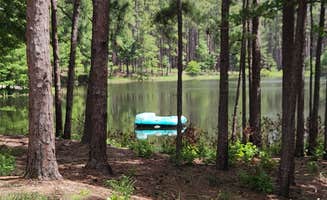Primitive camping near Silsbee, Texas offers opportunities within the Big Thicket National Preserve, a diverse ecosystem spanning over 100,000 acres with nine different land units. This region receives approximately 55 inches of annual rainfall, creating lush vegetation and diverse wildlife habitat. Camping areas feature sandy soil with longleaf pine stands, providing natural drainage during wet conditions.
What to do
Fishing at varied times: At Sexton Pond Dispersed, visitors can fish throughout the day, though some report specific windows of activity. "They seem to sit dormant at 10pm and 3am for a hour each. No biting," notes Yasmin S. about the fish behavior patterns.
Wildlife observation: The surrounding forest supports diverse wildlife populations including deer, birds, and small mammals. The Big Thicket ecosystem contains over 1,000 plant species, making it an ideal location for nature photography and wildlife watching.
Stargazing opportunities: Limited light pollution in these remote camping locations creates optimal conditions for night sky viewing. The forest canopy provides natural framing for star observation in established clearings.
What campers like
Natural isolation: Many visitors appreciate the seclusion available at undeveloped sites near Silsbee. "If looking to be near a campground but still out on your own then this is the place," writes Yasmin S. about Sexton Pond.
Accessibility for standard vehicles: Despite being primitive camping areas, most locations remain accessible without specialized equipment. Jennifer M. describes the approach to Sexton Pond as "Down a hard packed gravel road. A few potholes but nothing major."
Established camping spots: Previous use has created natural clearings appropriate for setting up camp. "There are a few fire pits spread out," notes Jennifer M., indicating defined areas for camping that reduce impact on surrounding vegetation.
What you should know
Dispersed camping regulations: The national forest and preserve lands near Silsbee operate under specific camping rules. Visitors should contact ranger stations for current restrictions on camping duration, fire regulations, and seasonal closures.
Limited cellular service: Remote camping areas may have inconsistent or non-existent phone coverage. Download maps and necessary information prior to arrival at Bouton Lake Camp and similar primitive sites.
Weather considerations: The eastern Texas climate includes high humidity and sudden thunderstorms. Summer temperatures regularly exceed 90°F with high humidity, while winter nights can drop below freezing.
Tips for camping with families
Water supply planning: With no potable water available, families must bring sufficient drinking water for the duration of their stay. Calculate at least one gallon per person per day, plus additional water for cooking and cleaning.
Insect protection: The humid forest environment supports active insect populations. Bring appropriate repellents and protective clothing, particularly during warmer months when mosquitoes are prevalent.
Safety measures: Establish clear boundaries for children when camping at primitive sites like Sexton Pond. "Nice spot in the trees," notes Jennifer M., but the natural setting includes typical forest hazards requiring parental supervision.
Tips from RVers
Site selection considerations: When bringing RVs to dispersed camping areas, select locations with adequate clearance for your vehicle size. "We were the only ones here," mentions Jennifer M., suggesting ample space for RV positioning at certain times.
Self-containment requirements: RVers must arrive fully supplied with water and waste capacity as no hookups or dump stations exist at these primitive camping locations. Plan for complete waste pack-out when camping at these undeveloped sites.
Access route assessment: While roads are typically passable, seasonal conditions may affect accessibility. Jennifer M. described the road to Sexton Pond as having "a few potholes but nothing major," indicating most RVs can access the site with proper caution.


